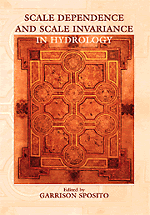Book contents
- Frontmatter
- Contents
- List of Contributors
- Preface
- 1 Scale Analyses for Land-Surface Hydrology
- 2 Hillslopes, Channels, and Landscape Scale
- 3 Scaling in River Networks
- 4 Spatial Variability and Scale Invariance in Hydrologic Regionalization
- 5 An Emerging Technology for Scaling Field Soil-Water Behavior
- 6 Scaling Invariance and the Richards Equation
- 7 Scaling of the Richards Equation and Its Application to Watershed Modeling
- 8 Scale Issues of Heterogeneity in Vadose-Zone Hydrology
- 9 Stochastic Modeling of Scale-dependent Macrodispersion in the Vadose Zone
- 10 Dilution of Nonreactive Solutes in Heterogeneous Porous Media
- 11 Analysis of Scale Effects in Large-Scale Solute-Transport Models
- 12 Scale Effects in Fluid Flow through Fractured Geologic Media
- 13 Correlation, Flow, and Transport in Multiscale Permeability Fields
- 14 Conditional Simulation of Geologic Media with Evolving Scales of Heterogeneity
- Index
7 - Scaling of the Richards Equation and Its Application to Watershed Modeling
Published online by Cambridge University Press: 18 January 2010
- Frontmatter
- Contents
- List of Contributors
- Preface
- 1 Scale Analyses for Land-Surface Hydrology
- 2 Hillslopes, Channels, and Landscape Scale
- 3 Scaling in River Networks
- 4 Spatial Variability and Scale Invariance in Hydrologic Regionalization
- 5 An Emerging Technology for Scaling Field Soil-Water Behavior
- 6 Scaling Invariance and the Richards Equation
- 7 Scaling of the Richards Equation and Its Application to Watershed Modeling
- 8 Scale Issues of Heterogeneity in Vadose-Zone Hydrology
- 9 Stochastic Modeling of Scale-dependent Macrodispersion in the Vadose Zone
- 10 Dilution of Nonreactive Solutes in Heterogeneous Porous Media
- 11 Analysis of Scale Effects in Large-Scale Solute-Transport Models
- 12 Scale Effects in Fluid Flow through Fractured Geologic Media
- 13 Correlation, Flow, and Transport in Multiscale Permeability Fields
- 14 Conditional Simulation of Geologic Media with Evolving Scales of Heterogeneity
- Index
Summary
The Problem of Scaling of Unsaturated Water Flow
Model studies of water transfer in saturated and unsaturated zones within soils have shown that there is an urgent need to assess the adequacy and usefulness of scale matching for the different flow phenomena involved in the interactions among the atmosphere, the land surface, vadose zones, and aquifers. Correct specifications of soil hydrologic processes for both small and large scales are directly dependent on the possibility of parameterizing soil-water fluxes for scales compatible with the grid size of the field scales involved. The difficulty of parameterization for soil-water dynamics arises not only from the nonlinearity of the equations for saturated and unsaturated flows but also from the mismatch between the scale of field measurements and the scale of model predictions. All of the standard measurement methods, such as the entire range of techniques to monitor in situ soil-moisture content and soil-water pressure, provide only point information and highlight the underlying variability in the hydrologic characteristics of soils. The efficiency of parameterization of soil characteristics at different scales depends on clear definitions of the functional relationships and parameters to be measured.
One of the first studies to apply the concept of scaling to the theory of water flow in unsaturated soils was that by Miller and Miller (1955a, b, 1956). They derived scale factors for soil-water properties such as soil-water pressure, hydraulic conductivity, diffusivity, and soil-water transport coefficients by the use of the similar-media concept.
- Type
- Chapter
- Information
- Scale Dependence and Scale Invariance in Hydrology , pp. 190 - 223Publisher: Cambridge University PressPrint publication year: 1998
- 14
- Cited by



